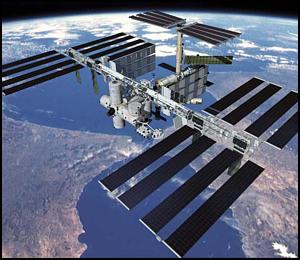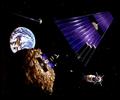
NASA Ames
Research Center
Larger image
Stanford
Torus habitat
(with Solar mirror and
active electron-gun
and passive Lunar-slag
shielding against hard
radiation and micro-
meteors) would rotate to
provide pseudo-gravity.
Only micro-gravity accommodations in orbit around the third planet outward from Sol are available within this system at present. However, construction proposals for bases on Earth's Moon and Mars as well as spacious space settlements with pseudo-gravity via habitat rotation have been in development since the 1970s.
Earth Orbit
-
Mir Space Station (1986-2001)
-
International Space Station : accommodations now under construction.

NASA
Side and larger images
International Space
Station at completion.
See also current
construction as of:
2/16/01; 12/11/00;
10/20/00; 9/18/00;
and 9/10/00.

NASA -- larger
image
Planetary Bases

NASA -- larger and
jumbo
images
Lunar
outpost, forerunner to a
permanent settlement on the Moon.

NASA -- larger and
jumbo
images
Mars
outpost for seven people
with a 16-meter, inflated habitat.
A Bernal Sphere habitat (at lower right of image below) can house over 100,000 people and support two possible space industries. Solar Power Satellites (SPS) and processing of near-Earth asteroids provide energy for a power-hungry planet as well as material resources for further development of planetary and orbital exploration and colonization.

NASA -- larger and
jumbo images
Space
settlements will be needed
for exploiting Solar energy and
asteroidal and cometary resources.